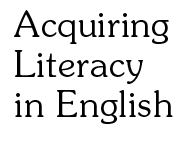Acquiring Literacy in English:
Crosslinguistic, Intralinguistic, and Developmental Factors
Subproject 2: Transfer of Reading Skills in Bilingual Children
| Principal Investigator: | Diane August, Center for Applied Linguistics |
| Co-Investigators: | María Carlo, University of Miami |
| Margarita Calderón, Johns Hopkins University |
Purpose
Study Subjects
Study Findings
Further Information
PURPOSE
Subproject 2 consisted of three sets of studies that examined the factors that influence English language literacy development in Spanish-speaking children. Study Sets 1 and 2 were longitudinal research projects that studied children from kindergarten through first grade and second through fifth grade, respectively. Study Set 3 was an intervention that investigated the possibility of “teaching for transfer,” that is, helping children to make explicit connections between their knowledge of their first language and their understanding of their second.
Each study set addressed specific research questions:
- Study Set 1: What is the nature of the development of phonological awareness and spelling in young bilingual children?
- Study Set 2: What is the relationship between language and literacy skills in Spanish and English?
What is the role of home literacy and language environment on bilinguals’ English and Spanish vocabulary development?
-
Study Set 3: Can interventions be developed that help third and fifth grade children transfer cognate knowledge from Spanish to English?
STUDY SUBJECTS
The sample for Study Set 1 consisted of 102 kindergarten and first grade children, in three groups: 45 bilingual children receiving Spanish literacy instruction only, 35 bilingual children receiving English literacy instruction only, and 22 English monolingual children receiving English literacy instruction. The sample for Study Set 2 included 189 students: 34 monolingual English speakers, 59 Spanish–English bilingual students in English-only instruction, and 96 Spanish–English bilingual students who received initial reading instruction in Spanish and then transitioned into English instruction. The sample for Study Set 3 consisted of approximately 160 third and fifth grade Spanish–English bilingual students.
STUDY FINDINGS
The main findings from the study are summarized below in reference to the four research questions.
Research Question 1: What is the nature of the development of phonological awareness and spelling in young bilingual children? (Study Set 1)
Findings: Spanish-instructed bilinguals were more likely than English-instructed bilinguals or English monolinguals to treat diphthongs as two units, reflecting the influence of Spanish language instruction on English phonological analysis. Moreover, both English vocabulary and literacy instruction made unique, positive contributions to English spelling, whereas Spanish literacy instruction played a more important role than Spanish vocabulary in the production of Spanish-influenced spelling in English. Only bilingual students in Spanish literacy instruction (SLI) exhibited Spanish-influenced spelling, indicating a strong effect of language of literacy instruction.
Research Question 2: What is the relationship between language and literacy skills in Spanish and English? (Study Set 2)
Findings: Research results demonstrated that first language reading skills are related to second language reading skills, but that children must have first language literacy in the skill for this relationship to exist; oral proficiency in the first language is not sufficient.
Research Question 3: What is the role of home literacy and language environment on bilinguals’ English and Spanish vocabulary development? (Study Set 2)
Findings:Becoming or staying proficient in English does not require parental use of English in the home. Spanish, not English, is the at-risk language for children of Hispanic heritage living in the U.S. Students need early instruction in Spanish and home support in that language in order to become and remain proficient in Spanish.
Research Question 4: Can interventions be developed that help third and fifth grade children transfer cognate knowledge from Spanish to English? (Study Set 3)
Findings: Results indicated that students in both the intervention curriculum and a control curriculum were able to spontaneously apply knowledge of Spanish words when require to infer the meaning of unfamiliar English words. In addition, results indicated no significant difference between the children in the intervention group and those in the control group in their ability to transfer cognate knowledge to words that were not targeted in the curriculum. Further analysis will investigate whether knowledge of the transfer cognate items is related to differences in Spanish frequency and whether this variable might help explain the lack of a transfer effect for cognates among students in the cognate intervention.
FURTHER INFORMATION
Read subproject summary [PDF, 58 KB]![]()
View list of publications resulting from the study
Read descriptions of assessments developed for the study
- Cognate Awareness Test (English)
- Extract the Base Test (English and Spanish)
- Test of Phonological Processing in Spanish (TOPPS)
- Diagnostic Assessment of Reading Comprehension (DARC)
- Phonological Transfer Test
- Spelling Transfer Test

